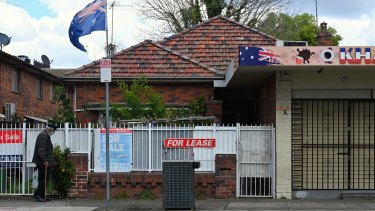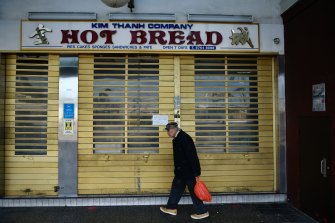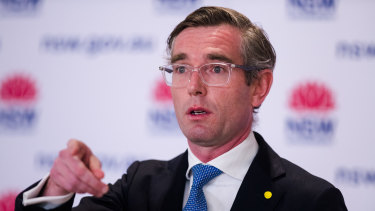Suburban fury Delta divide deepens over Sydney hotspot lockdowns
The residents of Hurlstone Park, on the fringe of Canterbury Bankstown, have had enough. Rising fury at hotspot COVID-19 restrictions and policing have led to a push to secede from their council and join the Inner West.
Their suburb was tacked onto the city’s most populous local government area, which sprawls across Sydney’s south-west, despite their objections, and now they’re stuck under onerous rules despite their suburb’s low case numbers and a high vaccination rate.

A man walks in front of his home in Fairfield during the COVID-19 lockdown. Credit:Kate Geraghty
“The anger is quite palpable, about how this ‘LGA of concern’ concept has affected us,†says Tim Jurd, a retired school principal. “Most definitely there will be a residual hostility to the decisions that were made here.â€
In nearby Campsie, many residents feel hurt and confused.
In normal times, pharmacist Angela Song’s job goes beyond filling medical scripts for elderly Korean residents to navigating the world of officialdom for them; she fills in their Centrelink forms and rings their electricity providers.
Lately, however, their questions have changed. They’re asking about the area’s tighter restrictions - a curfew, exercise limits, and constant police presence - with a mixture of fear and bewilderment. “They feel stigmatised,†she says. “[They ask], is it because we don’t speak English? We’re not an affluent part of society, is that why?â€

South-west suburbs have been hit hard by COVID-19Credit:SMH
Sydney is the most unequal city in Australia, a divide once acknowledged in the open rivalry between “westy†fibros and north shore silvertails but that no longer provokes as much public discussion.
As income continues to concentrate in the hands of the top 10 per cent, health, education and employment outcomes slide for many of those living on the wrong side of the so-called Latte Line, an imaginary divide running north-west from the airport that roughly cleaves the city on a host of economic and social indicators.
Uneven COVID-19 restrictions have brought dormant resentments roaring back to life. “It has definitely drawn more attention to existing inequalities in Sydney and shone a light on things that were pretty invisible,†says Sydney University’s Kurt Iveson, who researches the city’s geography.
Instead of imposing city-wide restrictions, as Melbourne did, the NSW Coalition government introduced a two-tiered system to target areas with higher cases. The 47 per cent of Sydneysiders subject to tighter restrictions includes some of the city’s most disadvantaged.
The decision spared half of the city the more onerous limitations, such as curfews and strict limits on exercise. It also worked; case numbers in hotspots are, slowly, going down. But from Penrith to Pagewood, anger is building over what many residents consider arbitrary, unfair and economically damaging rules. “We are so angry, but outside the hotspots no-one cares,†says Grace Smith, a public servant from Earlwood. “We feel like we have no power, and no voice.â€
Accusations that those in the west and south-west who speak up are fanning the flames of division have done little to quell that fury. Residents want to know what the government will do to make it up to them. And if it’s not enough, their anger could influence the next state election.
Division has been a hallmark of the Delta outbreak. The past few months have pitted state against state, region against city, council against council and even neighbour against neighbour, as residents follow ministerial directions to dob each other in.
“The national discourse is all about conflict,†says Professor Ian Hickie, the co-director of Health and Policy at the University of Sydney’s Brain and Mind Centre. “We’ve lost the capacity for empathy, for the difficulty other people face.â€
Hickie is concerned the division and resentment will linger well beyond the pandemic, deepening Sydney’s divisions and further marginalising those already at risk of alienation, such as the refugee and muslim communities. Professor Marc Stears, the director of the Policy Lab at the University of Sydney, agrees, and has been shocked by the willingness of those who usually speak out against inequality to look the other way as harsher restrictions - some with little evidence - were imposed on the most vulnerable.
“If you’d locked down [poorer] Brixton in London with different rules than [wealthier] Chelsea or Kensington, there would have been front page news,†he says. “You can’t help but worry that there were whole communities who just felt that nobody cared when things were really bleak for them.â€
The Delta outbreak began in mid-June, and by mid-August, 12 Local Government Areas had been declared hotspots due to rapidly climbing case numbers. That number hasn’t changed in more than a month. At first, they had stricter mask rules and more limits on unnecessary travel, but restrictions soon widened to essential workers, who needed regular testing to leave their area, a curfew, and an exercise limit. The curfew was lifted on Wednesday, but while vaccinated adults can now enjoy a picnic with four friends in other parts of Sydney, those in hotspot suburbs can only have one with members of their household, for no more than two hours.
The curfew was deeply unpopular. Berejiklian imposed it on hotspots on August 20, after saying for weeks that there was little evidence to support it. A fortnight later, Deputy Premier John Barilaro told regional journalists that curfews didn’t work and were imposed on residents due to media pressure. It hurt shift workers, and people who needed to dash to the shops unexpectedly or wanted a late evening walk. But for many, it was “more psychological,†says Jihad Dib, the Labor MP for Lakemba; an unfamiliar curb on freedoms. Berejiklian has defended all the decisions by saying they were based on health advice.

NSW Premier Gladys Berejiklian and Tourism Minister Stuart Ayres on Friday. Ayres expects Local Government Areas will no longer be used to mark boundaries of concern once a 70 per cent vaccination is achieved.Credit:Rhett Wyman
Residents have also been angered by the perception of inconsistency. Case numbers are growing and vaccinations are lower in the city and Randwick, yet they are not hotspots. Why is Burwood still an LGA of concern, when it has fewer cases than Waverley, which is not, asks Burwood Mayor John Faker? “It doesn’t make sense,†says Faker. “You can’t get a clear criteria [on what constitutes a hotspot] from anyone in the government. [Residents] are doing the right things but they’re still being punished.â€
Hotspot boundaries have also angered residents. The Coalition pushed council mergers in 2016, a policy never intended as a public health measure. Canterbury merged with Bankstown to become the city’s largest Local Government Area. Some councils, such as Woollahra and Waverly, did not merge, even though their union would have made more sense than plonking Botany and Rockdale, on different sides of the airport, in an awkward marriage to create Bayside, a hotspot. “The context of COVID, where the restrictions are at an LGA level, really highlights how some of this doesn’t make sense,†says Professor Roberta Ryan, a political sociologist at the University of Newcastle.
The only council area not made a hotspot in its entirety was Penrith. There, some suburbs - mostly those represented by Labor - were included, while others were not. Like her Burwood counterpart, Penrith Mayor Karen McKeown still does not know how the hotspot designation was decided, the criteria under which it will be lifted, or why Penrith became an exception.
Some residents have asked whether it was an attempt to protect cabinet minister Stuart Ayres’ marginal seat. “The perception out here is that the decisions are political, and in the absence of more information, what else can people think?â€.
Ayres “categorically rejected†that politics was involved in the decision. The cases leaked into the area from hotspots to the south, such as Liverpool. “Is the Mayor of Penrith really suggesting we should lock all of Penrith down?†he asks.
Ayres expects Local Government Areas will no longer be used to mark boundaries of concern once a 70 per cent vaccination is achieved. “It is incredibly blunt and while it worked when there was low vaccination, why would you knock out an entire LGA when there is 70, 80, 90 per cent vaccination?†he says.
Liberal MPs have also been pushing the government to base restrictions on suburbs rather than LGAs. But some don’t believe it’s the answer. “Given the high vaccination numbers, this proposal reinforces division when we need more unity,†says Lakemba Labor MP Jihad Dib.
Treasurer Dominic Perrottet has said he wants the whole city to emerge from lockdowns together, too, although Berejiklian has not yet backed that view. Perrottet, who has met most of the hotspot mayors over the past week, says the big challenge is restoring confidence. He will use the mayors’ feedback as he develops an economic recovery plan, which is expected in early October and likely to include funding for infrastructure, tutoring and mental health services. “We need to re-open as much of Sydney and NSW together to avoid disruptions and dislocations,†he tells the Herald.
If anger does not subside, some Coalition electorates will be in the firing line. Several of the party’s seats along the hotspot belt, including Parramatta and Oatley, are held by a slimmer margin due to a redistribution. East Hills, which covers the Revesby area, is held by Wendy Lindsay by a wafer-thin 0.5 per cent.

Treasurer Dominic Perrottet has said he wants the whole city to emerge from lockdowns together.Credit:James Brickwood
Labor leader Chris Minns was targeting those areas before the Delta outbreak, raising issues such as high tolls and rapid development. The growing fury over COVID-19 restrictions has given him a better shot at winning back the party’s traditional heartland.
“[The west and south-west is] the target for anyone looking to win the next election,†says Labor strategist Bruce Hawker. If residents’ anger dims in the 18 months until the March 2023 election, Labor will remind them. “How long did you spend in a hard lockdown with very limited movements allowed to you, with a curfew, when people in the eastern suburbs had no such restrictions?†he says.
There is mounting evidence that, while the lockdown has caused economic pain across the city, LGAs of concern have taken the hardest hit. Seven weeks after the city went into lockdown the largest employment losses were in Fairfield (down 17.7 per cent) Canterbury (17 per cent) and Bankstown (15.6 per cent), Australian Bureau of Statistics payrolls data shows.
Small independent firms in the west have also been hit harder, with purchases at that type of business plunging 70 per cent. In the north and east, spending at small retailers has been higher than pre-lockdown levels. Nick Kamper, from business analytics firm Purpose Bureau, warns western Sydney faces an “employment crisisâ€.
The restrictions may have been blunt and uneven, but they worked. Professor Mark Stoové from the Burnet Institute says they drove case numbers down, although he cannot pinpoint which measure was most effective because they were introduced in a bundle. However, cases in other areas of Sydney are now going up. He argues the restrictions should have been applied uniformly across the city. “It would be a pity for all the hard work of those 12 LGAs to ultimately be undone because cases are increasing elsewhere,†he says.
Discussion of the plight of people in hotspots irritates some residents of the northern beaches, who argue they did their bit for the state for three weeks over Christmas. Many businesses paid a heavy price; those who were forced to take out loans to survive the last lockdown have not survived this one.
Mayor Michael Regan admits to a little “us and them†resentment when the northern part of the region was locked down, yet the southern end was not. He says he heard from angry, lockdown-weary Victorians when he spoke out for his constituents doing it tough, but the majority of people were “positive and looking on the bright sideâ€. He criticised the western and south-western suburbs mayors for their outspokenness during the Delta outbreak, arguing they have fanned the flames of division by saying they deserved better.
However, Hickie says empathy for others is an important element of social cohesion. “The long-term impacts [will be] on those who are already marginalised; they become angry and more marginalised. Public health and mental health and wellbeing depends on shared pro-social values, not on more anger, more alienation.†Stears agrees. In order for the city to heal, he says, “people who usually care about those questions of inequality, injustice are going to have to start caring again and do what they usually do - be loud about the problem.â€
Sydney can learn lessons from its COVID-19 experience. One, says Professor Ryan, is that we really are all in this together, regardless of political or social differences. “You can be as rich as you like,†she says. “If everyone is not vaccinated, then none of us is safe.†Another is ensuring that infrastructure keeps pace with development, local services are properly funded and community voices are heard. “The real leaders in this have turned out to be community leaders, non-government organisations, people embedded in the community, trying to articulate what their community needs,†says Hickie.
Even if the economy bounces back, the hardest-hit workers and businesses will have depleted savings, mounting debts and lingering health issues, warns Iveson.
Andrew Charlton, who was economic adviser to former Prime Minister Kevin Rudd, says the post-lockdown period is an opportunity to “level up†economic prospects in Sydney. “What this crisis has shown is that western Sydney has quite a different economy to other parts of the city,†he says. It has a high share of small businesses, and many people in jobs that cannot be done from home. He suggests a mix of policies tailored to boost activity and employment in the west, including payroll tax relief for businesses, additional infrastructure investment and targeted support for young people who lost employment including skills training. “That feels like a real no-brainer to me,†he says. “It’s an opportunity to ensure there’s a real economic bounce in western Sydney.â€
Iveson warns that careful planning was needed to ensure the recovery phase did not deepen divisions. “Opening up as soon as we safely can has to be the goal, but it won’t magically bring us back together,†he says. “There are material inequalities that we are going to carry into that recovery but there are also a bunch of new divisions that are both social and geographical,†he says. “It is a moment for us to think carefully about how we come out of this and whether we help fix that, or potentially make it worse.â€
This article has been edited to clarify that Canterbury Bankstown is the biggest council area by population, not are.
The Morning Edition newsletter is our guide to the day’s most important and interesting stories, analysis and insights. Sign up here.

0 Response to "Suburban fury Delta divide deepens over Sydney hotspot lockdowns"
Post a Comment